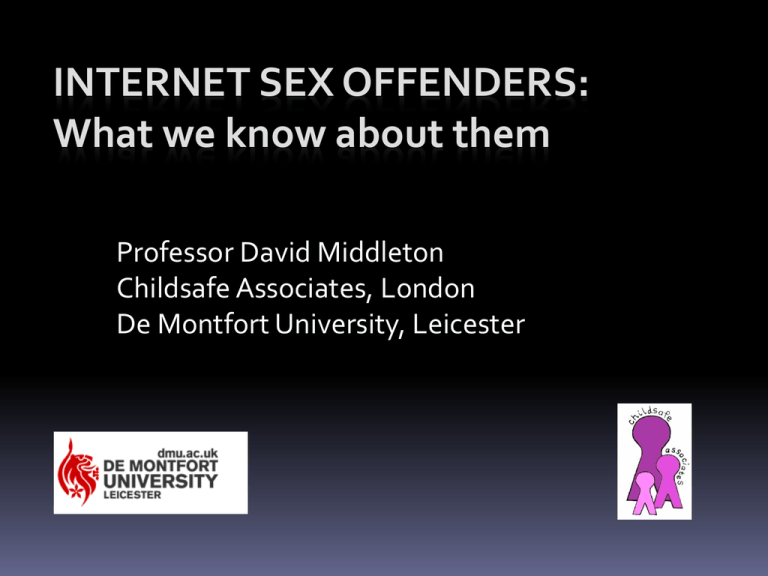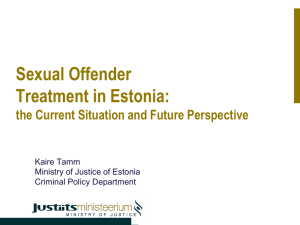
INTERNET SEX OFFENDERS:
What we know about them
Professor David Middleton
Childsafe Associates, London
De Montfort University, Leicester
Trends in Online child sex abuse
1. Internet Related sexual offences are increasing in
volume in most countries
2.
Producers may be commercial organised crime
3. Producers may be individuals involved in a private
network
4. Demand for images leads to new child sexual abuse
5. Some countries will act to have sites with indecent
images removed, some will block access
Conclusions
Internet Offenders are not a homogenous group
1. One of the sub groups are socially isolated people,
with intimacy deficits who meet their need for pseudo
intimacy, emotional and sexual needs through online
sexual activity
2. The second major group are those who are use
internet for emotional avoidance, soothing strategy in
response to emotional distress
3. The term “internet offender” covers a broad spectrum
of clinical presentation. A significant minority may not
present with the psychological characteristics
commonly found in child molesters.
“Child Pornography Possessors: Trends in Offender and Case Characteristics” Wolak,J.;Finkelhor, D.; and Mitchell, K. Journal of sex abuse 2011;23 22-42
Online Victimization (N-JOV) Study
Arrests for child
pornography possession
across 2,500 USA Law
enforcement agencies
Child Pornography Possessors: Trends in Offender and
Case Characteristics
Janis Wolak, David Finkelhor, and Kimberly Mitchell
SEX ABUSE 2011;23 22-42
What is the volume of traffic to
sites with child abuse images?
International Association of
Internet Hotlines (INHOPE)
33 hotlines in 29 countries
2004 – 2010
1.9m reports
60,200 unique reports per month
66% of these contained child sexual
abuse material
c.p. grew by 15% per yr
a.p. grew by 24% per yr
(source: www.inhope.org)
Online sex offending.
Downloading
Trading
Production
Grooming
Thanks to Dr Ethel Quayle
Trends in the USA 2000 -2006
In both 2006 and 2000, most offenders were
White, non-Hispanic males and socio-economically diverse.
Few were convicted of previous sex crimes.
Most had CP that depicted pre-teen children and serious sexual
abuse.
By 2006, a higher proportion of offenders were
ages 18 to 25,
used peer-to-peer (p2p) networks,
had images of children younger than three and CP videos.
P2p users had more extreme images (e.g., younger victims, sexual
violence) and larger numbers of images than those who did not use
p2p networks.
Child Pornography Possessors: Trends in Offender and Case Characteristics
Janis Wolak, David Finkelhor, and Kimberly Mitchell
SEX ABUSE 2011;23 22-42
Deviant sexual interests
- Sexual arousal to children
- Sexual preoccupation
Socio-Affective
Functioning
- management of relationships
- view of self and others
- Intimacy deficits
Distorted
Cognitions
- Attitudes supportive of
sex with children
- sexual entitlement
beliefs
SelfManagement
-Anti-social orientation
-Impulsivity
-Poor problem solving
Structured Risk Assessment (Thornton, 2002)
Do Sexual deviance risk factors apply to
internet offenders?
Sexual Deviance
Evidence of sexual arousal to children?
Evidence of sexual preoccupation?
What about images collected?
Sexual preference for children
“60% of convicted child pornography
users
without
contact
offences,
registered a PPG assessment indicative
of paedophilia – a higher proportion than
contact offenders”
Seto et al (2006)
Does severity of image tell us anything?
Level 1 erotic posing no sexual activity
Level 2 images depicting non-penetrative sexual activity between children;
or solo masturbation by child
Level 3 sexual activity between adults and children
Level 4 penetrative sexual activity involving child/children, or both child and
adults
Level 5 images of child/children depicting sadism, or penetration of or by
an animal
Low risk 72.6%
85% viewed all images including
Level 4 & 5
36% viewed level 5 images
Medium risk 21.9%
High risk 5.5%
15% viewed up to level 3 only
No high risk offenders viewed
level 5 images
Very High risk 0%
n = 72
25% of Medium risk and
35% of Low risk
had level 5 images
Osborn, Elliott, Middleton &
Beech 2010
Do Sexual deviance risk factors apply to
internet offenders?
Sexual Deviance
Evidence of sexual arousal to children?
Evidence of sexual preoccupation?
What about images collected?
)
Evidence for Distorted Attitudes?
Middleton et al (2006) less evidence of
cognitive distortions c.f. Offline offenders
(213 internet cf. 191 contact offenders)
Bates & Metcalfe (2007) Online offenders
less than offline on cognitive distortions and
victim empathy
Evidence for Distorted Attitudes?
Elliot et al (2009) Internet offenders tended to be
lower on Cognitive Distortions and higher on
Victim Empathy than Contact offenders
(n = 505 Internet n= 526 Contact)
Webb et al (2007) Internet Offenders scored lower
on “attitudes towards assault” than Contact
Offenders
(90/120)
“Self-Distancing” was dominant theme
The offence is construed as a privatised, imaginary affair
where real others are physically absent (intimacy
deficits).
Sophisticated rationalisations - children are unaffected
by (or even benefitted from) being photographed;
Rejection of sex offender tag not the same as contact
and flasher offences;
Rejection of sexual interest in children.
Winder, B. & Gough, B. (2010) “I never touched anybody –that’s my defence”:
A qualitative analysis of internet sex offender accounts. Journal of Sexual
Aggression 16,2. Pp.125-141
Distorted Attitudes
Evidence of Distorted Attitudes? mixed
Evidence of poor victim empathy towards child abuse? no
Evidence of post offence rationalisations? YES
Evidence of cognitive schema which precede or maintain
offence? mixed
Evidence for Problematic Socio-Affective Functioning?
Contact offender
data
Intimacy deficits
Internet data
25%
20%
21%
17%
Anti-social cognitions
8%
3%
Distorted sexual scripts
7%
5%
Pathways 1 and 3
15%
10%
n of sub-sample
124
135
n of Total sample
191
213
Emotional
dysregulation
Middleton et al (2006; 2008)
Predominant pathways
Middleton et al (2006) n = 72 of which 43 reported elevated scores
Intimacy Deficits [35%/n = 15]
- offend when lonely/rejected/adult relationships compromised
- experience high levels of emotional loneliness,
- difficulty in establishing age appropriate relationships, internet used for
pseudo-intimacy
Emotional Disregulation [33% n = 14]
- experience strong negative mood states over which lack of control,
combined with sexual desire,
- become disinhibited, use sex as a soothing strategy,
- internet pornography to alleviate negative emotions, increase feelings of
well-being
ON
Other Studies
Laulik et al 2006 (n = 30)
Personality Assessment Inventory (PAI: Morey 1991)
Compared internet offenders to normative
population
Internet offenders low on Warmth & Dominance
“indicates a rejecting and submissive interpersonal
style, which is thought to preclude effective
interaction with others”
Higher levels of depression
Other Studies
Webb et al (2007) found high levels of
intimacy deficits in both online and
offline offenders [90/120]
Morahan-Martin & Schumacher 2000
“viewing indecent images of children may
be used as a mechanism to escape from
negative mood states”
IBAQ DATA
MARITAL STATUS
HIGHEST
QUALIFICATION
Single
52
44.4%
Married
32
27.4%
Divorced / Separated
32
27.4%
No Formal Qualifications
15
12.4%
O-Levels, City & Guilds
27
22.3%
A-Levels
17
14.0%
University educated
40
33.0%
Elliott et al 23.4% in relationship
Webb et al 38% married
43% no co-habiting relationships +1yr
Self-Management
Contact
offender data
Internet data
31 (25%)
26 (21%)
27 (20%)
23 (17%)
Anti-social
cognitions
10 (8%)
4 (3%)
Distorted sexual
scripts
9 (7%)
7 (5%)
Pathways 1 and 3
18 (15%)
14 (10%)
Intimacy deficits
Emotional
dysregulation
Total of sub-sample 124
135
191
213
Total sample
Middleton et al 2006;2008
Self-Management
Middleton et al (2006); Elliott et al (2009)
Evidence for Impulsivity in internet offenders
Elliot et al found contact offenders found to have higher
levels of “making snap decisions “
Webb et al (2007) found Internet Offenders scored lower
on PCL-R than contact offenders
”
Self-Management
Seto (2009)
“Internet offenders score relatively low on
measures of anti-social tendencies,
(criminal history, antisocial personality traits,
antisocial attitudes and beliefs)
indicating they are less likely to act upon their
sexual interest in children”
Online escalating to offline?
Seto & Eke (2005; 2006; 2008)
Criminal records of child pornography offenders listed on Ontario Sex Offender Registry n=
201 adult males
2.5 yr follow up;
4% contact sexual offence
3.6 yr follow up
6.6% new contact sexual offence
5.9 yr follow up
8.5% new contact sexual offence
Prior conviction for sex or violence was best predictor of
new contact offence
Studies based on Official records examining prior
contact sex offences among online offenders
Elliot et al. (2008)
494
10.9%
(n = 54)
Prior
cons/Probation
Seto & Eke (2005)
201
11.9% (n = 24)
Prior charges
Galbreath et al. (2002)
39
7.7% (n = 3)
Prior charges/mental
health
Seto & Eke (2008)
301
5% (n = 15)
Prior
charges/convictions
Laulik et al. (2007)
30
6.7% (n = 2)
Prior convictions/Prob
Webb et al. (2007)
90
14.4% (n = 13)
Convicted and
unconvicted
charges/allegations
Wolak et al. (2005)
1,713 11% (n = 188)
Prior arrests/Police
Self Report studies
Online offenders admitting to past contact offences
Study
N
% with contact
offences
Source
Bourke & Hernandez
(2009)
155
84.5% (n = 131)
Self-reports
Buschman & Bogaerts
(in press)
Neutze et al. (2009)
38
55.3% (n = 21)
108
57.4% (n = 62)
Self-reports
(polygraph)
Self-reports
Quayle & Taylor (2003)
23
47.8% (n=11)
Self-reports
About half admit to past offences
Karl Hanson’s view:
Official data on 3,212
1 in 8 (13%) caught for both online & offline
sexual offences
Self report on 452
1 in 2 (50%) admit to both
Meta-analysis of 15 studies involving 3,536
offenders of which 18% appear to have
committed contact sexual offence
(Hanson & Babchisin 2009)
Summary
Reconvictions studies have produced a
wide variance
Prior convictions may be useful guide to
future sexual risk
Actuarial risk tools may be useful for rank
order but may overestimate actual risk
HYPOTHESIS
Internet Offenders are not a homogenous group
1. One of the sub groups are socially isolated people,
with intimacy deficits who meet their need for pseudo
intimacy, emotional and sexual needs through online
sexual activity
2. The second major group are those who are use
internet for emotional avoidance, soothing strategy in
response to emotional distress
3. The term “internet offender” covers a broad spectrum
of clinical presentation. A significant minority may not
present with the psychological characteristics
commonly found in child molesters.










